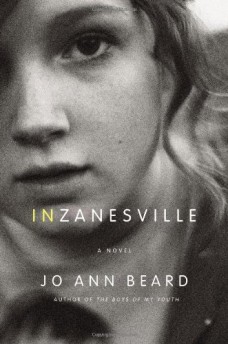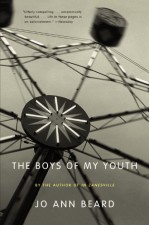 Reviewed:
Reviewed:
In Zanesville by Jo Ann Beard
Little, Brown, 304 pp., $23.99
The Boys of My Youth by Jo Ann Beard
Back Bay Books, 224 pp., $13.99
Cradle to grave, longing and loss animate our lives in unpredictable and bewildering ways. Particular moments, days or years may seem weighted by one or the other, but it’s when they converge that we really feel the knockout punch. This is the interior terrain, shot through with veins of courage and humor, that Jo Ann Beard illuminates with the startling clarity of a miner’s torch.
In Zanesville is Beard’s debut novel. Its narrator is a 14-year-old girl whose name we never learn, but her character recalls Beard’s 1998 collection of autobiographical essays, The Boys Of My Youth. In those essays, we see Beard as a child, adolescent and woman. The pieces are not arranged chronologically, and Beard effortlessly elides time, blending life’s stages, so that we see the child in the woman, and vice versa. Decades compress into the ornery, awkward, funny core of who she is. In Zanesville works an almost opposite magic: a teenager becomes Beard’s portal to the full evocation of a person that “it really didn’t occur to me to name,” Beard has said, “because I felt in some way that I was her.” We feel that way, too.
The novel is set in the 1970s, in an Ohio town dispatched in a single phrase as “the farm implement capital of the world.” Beard quickly zooms in with a cinematic rush to the neighborhood where the narrator and her friend Felicia, or Flea, live. The story opens with a fire, its danger obscured by the more pressing embarrassment of adolescence. Beard vividly establishes the in-between angst these friends feel as babysitters not quite in charge, through the comic details of their attempts to evacuate a house full of kids and animals, and as the hapless objects of adult response.
Beard chronicles the peculiarities of adolescence — the seemingly great distance from childhood, the confused rush to whatever comes next — through the filter of friendship. A self-described sidekick, our narrator is most comfortable in her role with Flea. The two navigate the fringes of ordinary life in Zanesville. They have adventures with shopping, marching bands, school detention, and eccentric neighbors. When the social order of high school exerts its inevitable pressure on their friendship in the form of cheerleaders and boys, our protagonist loses her protective bond with Flea. The resulting anxiety of separation, and awkward attempts at individuation, are described in particular, recognizable moments. We find her scrunched and overgrown in a childhood nook at home, staring in the mirror, spending too much time alone in the art room, fifth-wheeling it with the cool kids. Understated but escalating cries for help punctuate her days:
Felicia is the only person I never felt nervous around, the only person I could do certain things with — shoplift, look at the stars without feeling dread — the only person I could go call right now and just start talking like everything was okay and everything would in fact be okay.
Pick up the phone, is all. Go back to being who you were before everything became like this. Nothing happened! You were just at a party and boys chose everyone else, and your best friend stared at you with flat eyes and you walked in the woods and talked to a grandmother. Nothing happened, and yet it feels like something did, because things aren’t the way they were before. It’s like when you come home and your mother has changed the furniture around, and for one instant it’s like you’ve entered the next dimension over: it’s your living room but it’s not your living room. That’s how this feels, like if you tried to sit down, you might find out that the chair is over there.
 At home, our narrator navigates a fraught parental dynamic reminiscent of Beard’s earlier work. Throughout The Boys Of My Youth, the women in Beard’s family are pragmatic and palpable — one recognizes them in the way they fake out a child in a disciplinary duel, or cajole against bad behavior. Guardianship of the children is peripheral to sewing, cleaning, fishing, smoking, and gossip. Tender and tough by turns, not malicious, they are bewildered by various infantile heartbreaks, and administer kindness in an offhand way. The father in Beard’s essays is an alcoholic who routinely imperils himself on binges. We see the evidence of this in “The Family Hour,” which describes the aftermath of a car crash — a kitchen wrecked by bloodied towels, black eyes, and broken teeth. The narrator’s parents in In Zanesville have similar traits that play out differently. The mother is more fed up, overworked and isolated. The father’s drunken drama is largely expressed in disappearing acts, and in the oft-repeated absurd refrain, “I’ll say This about That!” Nothing bad actually happens, except in the narrator’s imagination. As she moves towards her first encounters with boys, she sustains a wary vigilance over her father by tracking the whereabouts of his shotgun and shells in the house.
At home, our narrator navigates a fraught parental dynamic reminiscent of Beard’s earlier work. Throughout The Boys Of My Youth, the women in Beard’s family are pragmatic and palpable — one recognizes them in the way they fake out a child in a disciplinary duel, or cajole against bad behavior. Guardianship of the children is peripheral to sewing, cleaning, fishing, smoking, and gossip. Tender and tough by turns, not malicious, they are bewildered by various infantile heartbreaks, and administer kindness in an offhand way. The father in Beard’s essays is an alcoholic who routinely imperils himself on binges. We see the evidence of this in “The Family Hour,” which describes the aftermath of a car crash — a kitchen wrecked by bloodied towels, black eyes, and broken teeth. The narrator’s parents in In Zanesville have similar traits that play out differently. The mother is more fed up, overworked and isolated. The father’s drunken drama is largely expressed in disappearing acts, and in the oft-repeated absurd refrain, “I’ll say This about That!” Nothing bad actually happens, except in the narrator’s imagination. As she moves towards her first encounters with boys, she sustains a wary vigilance over her father by tracking the whereabouts of his shotgun and shells in the house.
Beard’s stories are full of near misses: deer do not leap into oncoming headlights; spiders do not bite; fire does not engulf; teens don’t drown. She maintains a continuous tension between these disasters that don’t occur, and the losses that do, as dolls perish by soaking, mothers by cancer, friends by gunshot, marriage by adultery.
Critters and dolls are supporting characters throughout the fiction and essays. In Zanesville starts off with the evacuation of a menagerie of pythons, mice, and tarantulas. A neighbor’s dog, living out its life at the end of a chain, haunts the novel. Together, the two friends secretly nurse a trio of abandoned kittens. In “Bulldozing the Baby,” from The Boys Of My Youth, a favorite doll, poor drowned Hal, gets tossed away. And in “The Fourth State of Matter,” Beard tends her beloved dying collie while squirrels rampage through the attic.
Beard is a generous and disciplined writer, and a wonderful stylist. Intensely personal, unsentimental and funny, her skill with narrative loops reifies our sense of how time expands and contracts — how a childhood night-light can haunt a grownup’s experience of the full moon, or a magic baby bottle can inform a teenager’s beer-chugging session. The inward, almost claustrophobic draw of Beard’s voice sacrifices nothing to artifice and makes insiders of us all. Just when one feels the interiority will finally close in, she rescues us with a tossed baton, a fish suspended in mid-leap, and we find ourselves “hooked to a star, as if flung outward into a night sky.”
Lila Garnett is a photographer, photo consultant, and writer living in Brooklyn.
Mentioned in this review:

